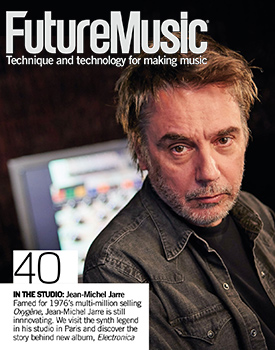 Famed for his stunning live concerts and the multi-million selling album Oxygene of 1976, French composer and electronic pioneer Jean-Michel Jarre is still going strong. Having studied under visionary musicologist Pierre Schaeffer in the ’50s, Jarre has a unique and fascinating insight into the unfolding history of electronic music, and has continued that legacy of experimentation throughout a career spanning five decades. This year, Jarre reveals Electronica, a huge project that sees him join forces with an army of collaborators whose own forays into electronic music have played an inspiring role. The first album, Electronica 1: The Time Machine, is released this autumn, with a second volume to follow in April 2016. Meanwhile, Jarre has plans to take it to the road for another live spectacular.
Famed for his stunning live concerts and the multi-million selling album Oxygene of 1976, French composer and electronic pioneer Jean-Michel Jarre is still going strong. Having studied under visionary musicologist Pierre Schaeffer in the ’50s, Jarre has a unique and fascinating insight into the unfolding history of electronic music, and has continued that legacy of experimentation throughout a career spanning five decades. This year, Jarre reveals Electronica, a huge project that sees him join forces with an army of collaborators whose own forays into electronic music have played an inspiring role. The first album, Electronica 1: The Time Machine, is released this autumn, with a second volume to follow in April 2016. Meanwhile, Jarre has plans to take it to the road for another live spectacular.
When digital technology came along, did you embrace it as eagerly as you had analogue?
“In terms of instruments, I think that electronic music went through some difficult times. It’s linked with the CD actually— the phenomenon of leaving vinyl and thinking that CD was the Holy Grail of technology, yet we know today that it was worse than vinyl, and MP3 is worse than CD, which was the 78 of the digital era It’s the same with the Japanese digital instruments. When the Yamaha DX7 was out, everybody thought that this was the future and analogue instruments were behind us. Everybody said it’s great, because you have presets, you can do whatever you want, but you were not as free to create the sounds you wanted in an intuitive way. Digital spent 15 to 20 years trying to compete with the warmth and sound of analogue, but only in the last five years with plug-ins like Diva, Dune, Monard, Omnisphere and the Native Instruments ones, is there a real new way of competing with the analogue Moog, Memorymoog or ARP 2600.”
Continue reading “Tech Interview to Future Music (2015)”


